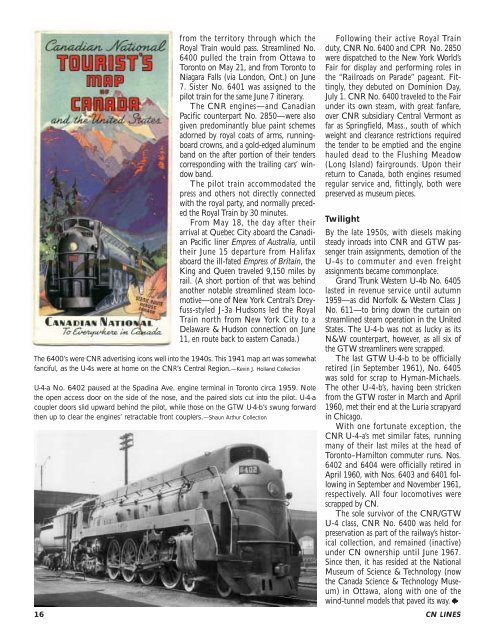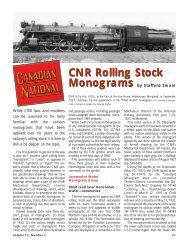CN LINES V12N3 - Canadian National Railways Historical Association
CN LINES V12N3 - Canadian National Railways Historical Association
CN LINES V12N3 - Canadian National Railways Historical Association
Create successful ePaper yourself
Turn your PDF publications into a flip-book with our unique Google optimized e-Paper software.
from the territory through which the<br />
Royal Train would pass. Streamlined No.<br />
6400 pulled the train from Ottawa to<br />
Toronto on May 21, and from Toronto to<br />
Niagara Falls (via London, Ont.) on June<br />
7. Sister No. 6401 was assigned to the<br />
pilot train for the same June 7 itinerary.<br />
The <strong>CN</strong>R engines—and <strong>Canadian</strong><br />
Pacific counterpart No. 2850—were also<br />
given predominantly blue paint schemes<br />
adorned by royal coats of arms, runningboard<br />
crowns, and a gold-edged aluminum<br />
band on the after portion of their tenders<br />
corresponding with the trailing cars’ window<br />
band.<br />
The pilot train accommodated the<br />
press and others not directly connected<br />
with the royal party, and normally preceded<br />
the Royal Train by 30 minutes.<br />
From May 18, the day after their<br />
arrival at Quebec City aboard the <strong>Canadian</strong><br />
Pacific liner Empress of Australia, until<br />
their June 15 departure from Halifax<br />
aboard the ill-fated Empress of Britain, the<br />
King and Queen traveled 9,150 miles by<br />
rail. (A short portion of that was behind<br />
another notable streamlined steam locomotive—one<br />
of New York Central’s Dreyfuss-styled<br />
J-3a Hudsons led the Royal<br />
Train north from New York City to a<br />
Delaware & Hudson connection on June<br />
11, en route back to eastern Canada.)<br />
The 6400’s were <strong>CN</strong>R advertising icons well into the 1940s. This 1941 map art was somewhat<br />
fanciful, as the U-4s were at home on the <strong>CN</strong>R’s Central Region.—Kevin J. Holland Collection<br />
U-4-a No. 6402 paused at the Spadina Ave. engine terminal in Toronto circa 1959. Note<br />
the open access door on the side of the nose, and the paired slots cut into the pilot. U-4-a<br />
coupler doors slid upward behind the pilot, while those on the GTW U-4-b’s swung forward<br />
then up to clear the engines’ retractable front couplers.—Shaun Arthur Collection<br />
Following their active Royal Train<br />
duty, <strong>CN</strong>R No. 6400 and CPR No. 2850<br />
were dispatched to the New York World’s<br />
Fair for display and performing roles in<br />
the “Railroads on Parade” pageant. Fittingly,<br />
they debuted on Dominion Day,<br />
July 1. <strong>CN</strong>R No. 6400 traveled to the Fair<br />
under its own steam, with great fanfare,<br />
over <strong>CN</strong>R subsidiary Central Vermont as<br />
far as Springfield, Mass., south of which<br />
weight and clearance restrictions required<br />
the tender to be emptied and the engine<br />
hauled dead to the Flushing Meadow<br />
(Long Island) fairgrounds. Upon their<br />
return to Canada, both engines resumed<br />
regular service and, fittingly, both were<br />
preserved as museum pieces.<br />
Twilight<br />
By the late 1950s, with diesels making<br />
steady inroads into <strong>CN</strong>R and GTW passenger<br />
train assignments, demotion of the<br />
U-4s to commuter and even freight<br />
assignments became commonplace.<br />
Grand Trunk Western U-4b No. 6405<br />
lasted in revenue service until autumn<br />
1959—as did Norfolk & Western Class J<br />
No. 611—to bring down the curtain on<br />
streamlined steam operation in the United<br />
States. The U-4-b was not as lucky as its<br />
N&W counterpart, however, as all six of<br />
the GTW streamliners were scrapped.<br />
The last GTW U-4-b to be officially<br />
retired (in September 1961), No. 6405<br />
was sold for scrap to Hyman-Michaels.<br />
The other U-4-b’s, having been stricken<br />
from the GTW roster in March and April<br />
1960, met their end at the Luria scrapyard<br />
in Chicago.<br />
With one fortunate exception, the<br />
<strong>CN</strong>R U-4-a’s met similar fates, running<br />
many of their last miles at the head of<br />
Toronto–Hamilton commuter runs. Nos.<br />
6402 and 6404 were officially retired in<br />
April 1960, with Nos. 6403 and 6401 following<br />
in September and November 1961,<br />
respectively. All four locomotives were<br />
scrapped by <strong>CN</strong>.<br />
The sole survivor of the <strong>CN</strong>R/GTW<br />
U-4 class, <strong>CN</strong>R No. 6400 was held for<br />
preservation as part of the railway’s historical<br />
collection, and remained (inactive)<br />
under <strong>CN</strong> ownership until June 1967.<br />
Since then, it has resided at the <strong>National</strong><br />
Museum of Science & Technology (now<br />
the Canada Science & Technology Museum)<br />
in Ottawa, along with one of the<br />
wind-tunnel models that paved its way.<br />
16 <strong>CN</strong> <strong>LINES</strong>



